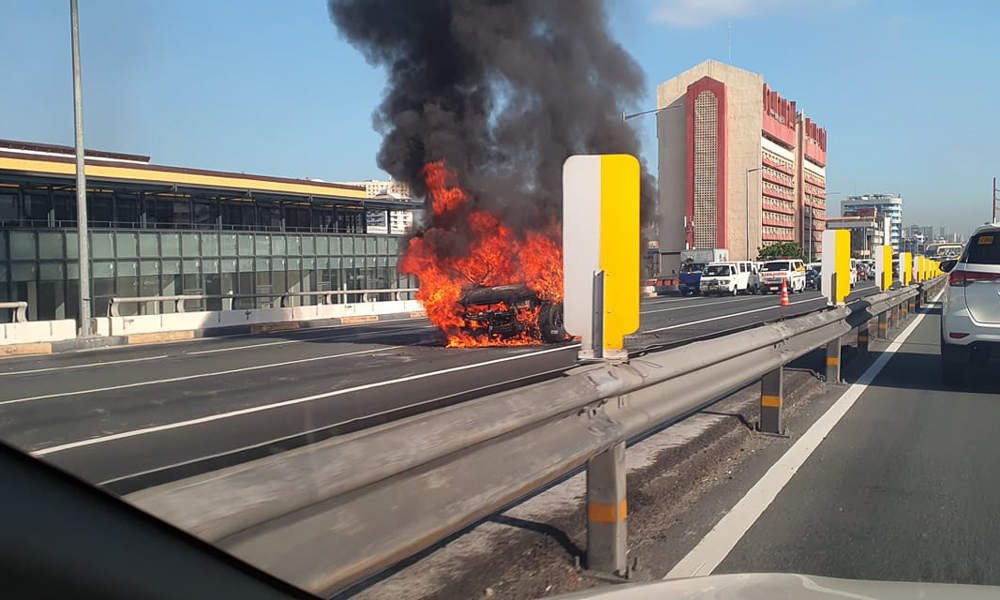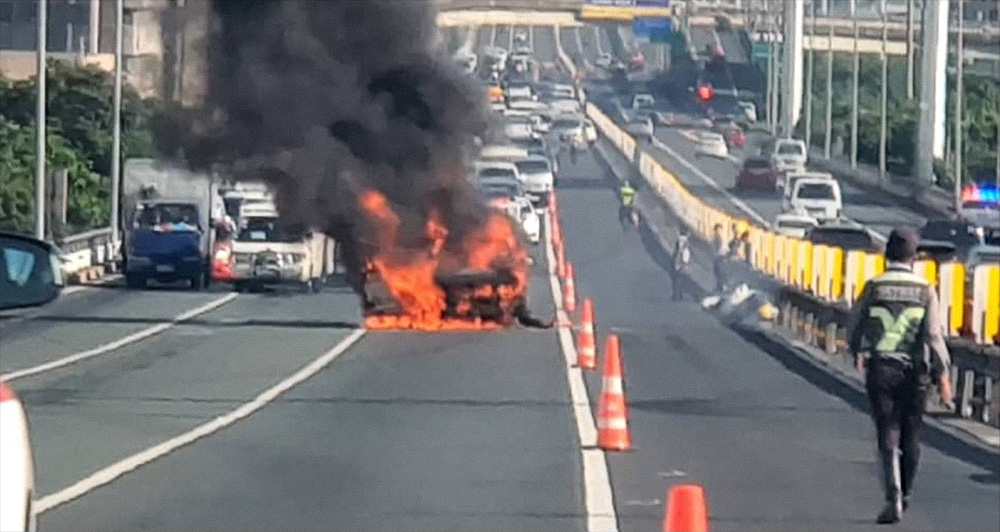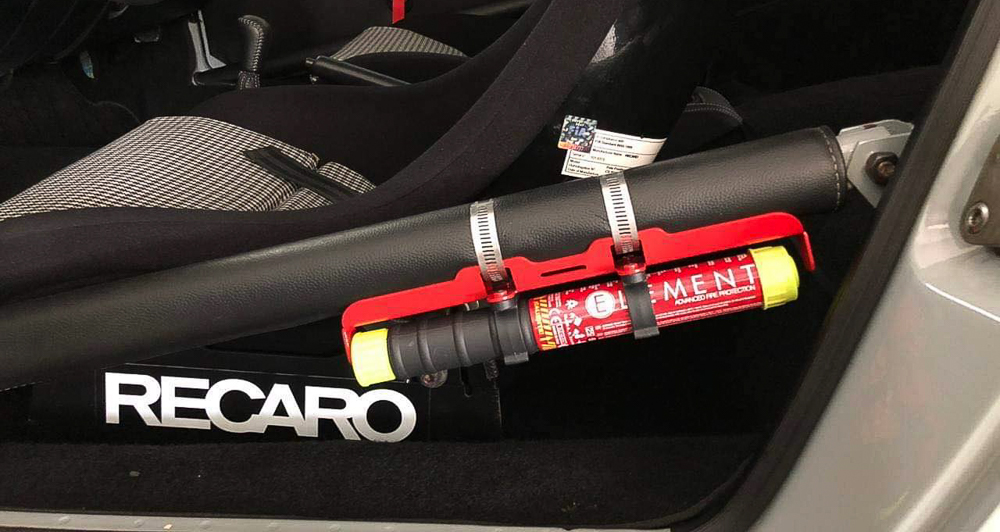
You never know what’s going to happen.
Videos of a burning SUV on the Skyway spread like wildfire across social media yesterday morning. Vehicular fires aren’t actually that rare, and you may have heard or even come across one at some point. With the advent of electric vehicles with energy-dense lithium batteries, managing blazes becomes even more imperative.
One way that you can manage such a risk is through having fire suppression in your vehicle. Your car probably has one designed right into it—the pad underneath the hood in modern vehicles is designed to drop down and smother an engine fire.
Some countries require portable fire extinguishers to be built into vehicles for use by their occupants. The racing scene sees a lot of regulation regarding portable and automatic fire suppression, and our very own Land Transportation and Franchising Regulatory Board mandates the presence of fire extinguishers in PUVs and school buses.

Should you have one, though?
First, we need to discuss the many types of fire extinguishers out on the market. Thankfully, these have all been sorted out according to the class of fire they’re designed to extinguish.
- Class A fires involve combustible materials such as wood, paper and fabrics. You can consider these as your basic fires, and can be put out with plain water.
- Class B fires involve combustible liquids and gases. These cannot be put out reliably with water alone, as a lot of fluids (like gasoline) will float on water.
- Class C fires involve electrical components, but may not necessarily be caused by electricity. We all know water and electricity don’t mix, and plain old H2O may end up not only destroying the equipment being extinguished but can also make the situation far riskier with the potential for shorts and electrocution.
- Class D fires involve burning metal. This is probably something not a lot of us will encounter as the typical metals we use such as steel and aluminum are fairly inert and rarely catch on fire, and each specific metal may require differing extinguishing agents.
- Class K fires are common in the household as they involve burning oils and grease. Do not pour water on these as steam will be rapidly generated, turning a burning pan into a fireball.
To fight all these, you need to select the appropriate extinguishing agent for the job. The most common agent in use is water. It’s the bread and butter of fire departments as it is readily available from hydrants and the environment. Plain water is really only good for Class A fires as it makes other types of fires worse.
A step up from plain water is Aqueous Film Forming Foam (AFFF) or Film-Forming Fluoroprotein Foam (FFFP) fire extinguishers. These are concentrates that mix in with water to create a foam that helps with smothering Class B fires and provides much greater effectivity against Class A fires.
Some AFFF fire extinguishers are rated to provide 23 times more extinguishing capacity than plain water. AFFF extinguishers tend to be cheaper, but most are not rated for Class C fires as they still use water as their main agent.

The most common type of portable fire extinguisher for sale and in use is the dry chemical extinguisher. These are usually rated for Class ABC fires, and are inexpensive and readily available.
Most of these extinguishers use monoammonium phosphate powder, which melts to draw heat away and smother flames, giving it six times as much extinguishing capacity as water. The fine powder, however, makes for a mess that is hard to clean. Monoammonium phosphate, in both its melted and wet forms, makes for a corrosive compound that will attack metal. In situations where extinguishers are used for emergencies, dry chemical extinguishers excel for their cost and weight, but will usually leave equipment ruined.
For such sensitive equipment, however, so-called clean agents exist. HFC236fa and HCFC123 are compounds that boil close to room temperature and leave no trace afterward, and are thus used as extinguishing agents for servers and hospital scanners. They work for Class ABC fires by drawing heat away and displacing oxygen, which is why room-size fire-suppression systems involving these require special caution so occupants aren’t stuck inside to suffocate.
They aren’t as effective as dry chemical or AFFF, however: a 10lb fire extinguisher only has as much extinguishing power as 10lb of water, and some smaller sizes are not even Class A-rated. These two compounds have replaced ozone-depleting agents such as Halon, but serve their own ills to the atmosphere with HFC236fa being 6,300 times worse than carbon dioxide as a greenhouse gas.
Carbon dioxide is also an extinguishing agent, commonly in use for Class B and C fires. It’s largely ineffective for Class A fires in open areas as the gaseous discharge is not enough to smother the fire, unlike powders and liquids. Carbon-dioxide extinguishers are more often used in server equipment, or with nonmetallic tanks around MRIs.

Finally, there are novel fire extinguishers available on the market that turn the idea of what a fire extinguisher should look on its head.
Fire extinguisher balls are one of the more marketed ones locally, but are basically a glorified dry chemical extinguisher utilizing monoammonium phosphate. There are also extinguisher sticks sold under several brands that utilize a chemical reaction to generate anions that displace oxygen and generate an inert gas to smother a flame.
While these do probably work and are certified by several governing bodies, they may not carry the same certifications and standards as traditional portable fire extinguishers as regulations have yet to adapt to their form factors.
That doesn’t really answer the question of whether you should have a fire extinguisher in your car, does it? Well, ultimately, the decision rests on you—how important the capability is for you, and what it is that you wish to protect. Fire extinguishers play the important role of managing fires right when they start, either putting them out or buying enough time until emergency crews can deal with them properly.
In the case of vehicular fires, the precious seconds you buy can aid in evacuating persons inside a car. While dry chemical extinguishers will cause additional corrosion damage to your vehicle when discharged, their small size and extinguishing capability make them a great choice for a lot of people who need them for emergency purposes.
For those that would prefer clean agents, know that their extinguishing capacity is nowhere near as good as AFFF or dry chemicals. Cars built for racing tend to have plumbed systems built right into them, with most using AFFF to pass certifications such as FIA’s.

If you will get one, there are still a few more things to consider. You can use small general-purpose fire extinguishers, but weight becomes a concern both for usability and safety. You’ll want to pick a size you don’t have to struggle to lift and use, and you’ll want to get a purpose-built mounting bracket for it that holds it securely yet undoes quickly for when you need it.
A 10lb fire extinguisher will weigh as much as 450kg in a typical crash, and can kill you if it turns into a projectile. Vibrations from being in a car will compact the dry chemical powder into a hard block, and be harsh on most other extinguishers, so make sure you take it out, inspect it, and give it a good shake every once a month or so.
Lastly, make sure you know when and how to use a fire extinguisher. The last thing you want in an emergency is to fumble around not knowing how to use the tools you have at hand.
But arguably the most important preparation you can do for a vehicle fire is to prevent one from happening in the first place. Keep your car in tip-top shape; avoid idiotic sketchy aftermarket installations; have frequent inspections alongside your PMS schedules; and avoid keeping unsecured flammable substances in your car.
Remember: “An ounce of prevention is worth a pound of cure.”











Comments